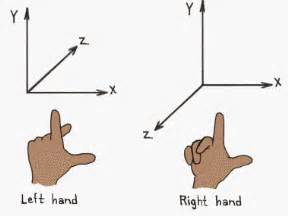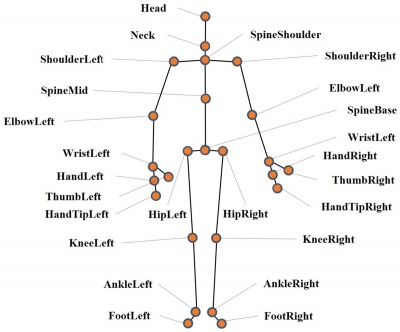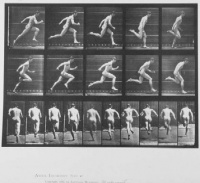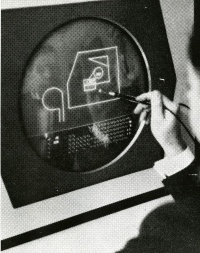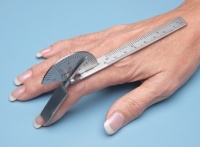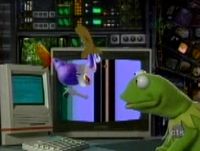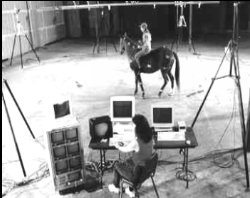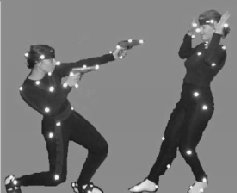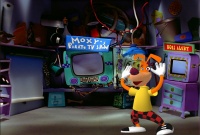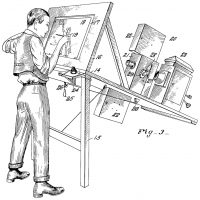Difference between revisions of "Resources:Possible Bodies"
Frankiezafe (Talk | contribs) (→Related topics) |
Frankiezafe (Talk | contribs) (→Pidepal model) |
||
| Line 13: | Line 13: | ||
[[File:Fig-4-2x.jpg|400px]] | [[File:Fig-4-2x.jpg|400px]] | ||
| + | |||
| + | The figure is already present in the MIT — Graphical Marionette in 1982. | ||
[[wikipedia:Bipedalism|Bipedalism]] | [[wikipedia:Bipedalism|Bipedalism]] | ||
Revision as of 19:32, 12 May 2017
Notes about Possible Bodies
Contents
Left / Right hand in 3d
- Left- vs. Right-handed coordinate systems - https://www.evl.uic.edu/ralph/508S98/coordinates.html
- http://viz.aset.psu.edu/gho/sem_notes/3d_fundamentals/html/3d_coordinates.html
Pidepal model
The main question here is: when the "stickman"[1] reduction appears and why is it mainstream.
The figure is already present in the MIT — Graphical Marionette in 1982.
Motion Capture
History
1963
Ivan Sutherland - Sketchpad
1980-1983
Simon Fraser, University — Goniometers
Tom Calvert, université Simon Fraser: https://www.linkedin.com/in/tom-calvert-7124575/
1982-1983
MIT — Graphical Marionette
Graphical Marionette from bob stein on Vimeo.
- Ginsberg
- Maxwell
system: Op-Eye
tech: capture optique
1988
deGraf/Wahrman — Mike the Talking Head - http://www.motion-capture-system.com/resources/Documents/History2.htm
1988
Pacific Data Images — Waldo C. Graphic
tech: exo-squelette & potentiomètres partie haute du corps + "dialbox" pour le visage et le lipsync
custom eight degree of freedom input device (a kind of mechanical arm with upper and lower jaw attachments)
1989
Motion Analysis existe toujours (-trouver site-)
tech: capture optique
1992
Protozoa (société pays?) - Moxy (cartoon network) - The Moxy Show
tech: capture magnétique
mid's 1980
Biomechanics lab, Utah State University, USA
The biomechanics laboratory at USU can be rooted back to the mid 1980’s when Steve Dunn began using a dedicated space in the HPER building to teach basic hands-on concepts related to biomechanics.
Researchers
- Steve Dunn
- Julianne Abendroth-Smith
- Gerry Smith
sources:
- https://www.siggraph.org/education/materials/HyperGraph/animation/character_animation/motion_capture/history1.htm
- http://www.usu.edu/biomechanics/historybio
Media industry
1970s-2001
rotoscoping
1995-2006
The First Motion-Capture Characters
(In relation with Biomechanics lab) Acclaim ASF format, described here
#
# Comment line
##
#
:version 1.10
:name BioSkeleton
:units
mass 1.0
length 1.0
angle deg
:documentation
Example of an Acclaim skeleton
To be used with "Walk.amc"
:root
axis XYZ
order TX TY TZ RZ RY RX
position 0.0 0.0 0.0
orientation 0.0 0.0 0.0
:bonedata
begin
id 1
name hips
direction 0.000000 1.000000 0.000000
length 0.000000
axis 0.00000 0.00000 0.00000 XYZ
dof rx ry rz
limits (-180.0 180.0)
(-180.0 180.0)
(-180.0 180.0)
end
begin
id 2
name hips1
direction 0.000000 1.000000 0.000000
length 4.310000
axis 0.000 0.000 0.000 XYZ
end
source
- https://www.yahoo.com/movies/a-brief-history-of-motion-capture-in-the-movies-91372735717.html
- http://the.honoluluadvertiser.com/article/2002/May/14/tc/tc02a.html
- Acclaim ASF/AMC format : http://research.cs.wisc.edu/graphics/Courses/cs-838-1999/Jeff/ASF-AMC.html
- http://c.chasserat.free.fr/TPE2/defhistorique.html
- http://www.motion-capture-system.com/resources/Documents/History2.htm
Related topics
Definition and list of motion capture methods: https://en.wikipedia.org/wiki/Motion_capture
Animation database - An animation database is a database which stores fragments of animations or human movements and which can be accessed, analyzed and queried to develop and assemble new animations.
Gesture recognition - Gesture recognition is a topic in computer science and language technology with the goal of interpreting human gestures via mathematical algorithms. Gestures can originate from any bodily motion or state but commonly originate from the face or hand.
Finger tracking - In the field of technology and image processing, finger tracking is a high-resolution technique that is employed to know the consecutive position of the fingers of the user and hence represent objects in 3D.
Inverse kinematics - (a different way of making CGI effects realistic).
Kinect (created by Microsoft Corporation).
Motion capture acting - Motion-capture acting, also called performance-capture acting, sometimes abbreviated as MoCap or Pcap, is a type of acting in which an actor wears markers or sensors on a skintight bodysuit or directly on the skin.
From duckduckgo search resulst: https://duckduckgo.com/?q=motion+captrure&t=lm&ia=web&yeg=B
- ↑ Definition of stickman by the free dictionary
